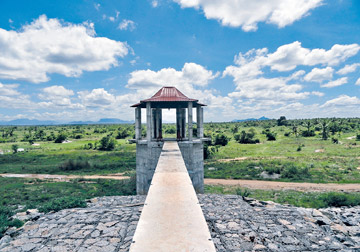|
Water supply assured for agricultural areas:
Over 30,000 acres to benefit from Deduru Oya project
By P. Krishnaswamy
|

The sluice gate under construction
|
The Rs.9.5 Billion Deduru Oya Reservoir Project, now nearing
completion, is the next in line to be commissioned under the ‘Mahinda
Chintana' concept followed by the Rs.3,970 million multipurpose
Rambakkan Oya Irrigation and Water Supply Project that was declared open
by President Mahinda Rajapaksa yesterday, July 20. This major
agricultural and rural development project will provide irrigation
facilities to about 30,000 acres of arable lands situated in Yapahuwa,
Wariyapola, Nikeweratiya, Panduwasnuwara, Bingiriya and Anamaduwa
electoral districts.
About 15,000 agricultural families will be directly benefited under
this project while about 50,000 families will be indirectly benefited.
The storage capacity of the reservoir is 75 MCM. Of the estimated
payment of compensation of Rs.1.8 billion to the 900 families who got
displaced under the project, an amount of Rs.942 million has already
been paid.
Infrastructure facilities to the people of the Maho, Wariyapola and
Ganewaththa Divisional Secretariat divisions include road networks,
electricity, schools and clean drinking water which will immensely
contribute to the improvement of their quality of life. Everything,
beginning from conducting the feasibility study to designing the various
components of the reservoir construction, was done by engineers of the
Irrigation Department and this is considered to be a unique achievement
of the Sri Lankan engineers.

The RB sluice outlet |
 |
| Completed
section of the main dam |
 |
| Construction
in progress |
The main problem hitherto faced by farmers in the Deduru Oya and Mee
Oya basins is the non-availability of assured water supply for the
agricultural areas since the basins are predominantly situated in the
dry zone of the country. The water available with the rainfall and
collected in the existing irrigation schemes is not sufficient for two
season cultivation.
Seventy percent of annual rainfall in the Deduru Oya catchment flows
to the ocean without being utilised in any way to serve the needs of the
local population. As a result an optimal level of agricultural
development has not been achieved. The Deduru Oya Reservoir project, on
completion, will resolve all these problems while bringing many more
benefits.
Director Eng. B. A. S. Sunil Perera expressed optimism that paddy
cultivation in the zone will be increased many fold beginning from the
forthcoming Yala season and the 2013/14 Maha season, with irrigation
water to be released for the Left Bank main canal in October, followed
by water release for the Right Bank main canal (up to Kiridigalla) in
November. This will contribute to consolidating the national plan of
food security in the country, he said. The project will attract a
tourist flow to the project site and the surrounding settlement areas,
he said.
The productivity of not only paddy but also other highland crops,
including vegetables and fruits, will increase many fold contributing
further to the socio-economic betterment of the agricultural families.
About 700 families have already been resettled in other locations with
allotment of land plots of half-an-acre to one acre.
 |
|
Construction work in
progress on the main sluice |
While the entire work on the construction of the causeway has been
completed, about 90 percent of the work on the main bund, the left bank
sluice, the right bank sluice, the spillway and rip
rap/toe/filter/turfing have been completed. The project will be
commissioned in early 2014. Also the work on the Trans basin Canal,
Maggalla Right Bank extension and 44 km LB canal have almost been
completed. Up to end of last year the total amount spent under the
project is Rs.7,000 Million while another Rs.2,500 Million is the
estimated expenditure before the completion of the project, according to
project authorities. The necessity of development programs for the
benefit of the population of the dry zone and intermediary zones in Sri
Lanka arose due to many reasons but mainly owing to the food security of
the people. The lack of food security arose due to disruption of
agrarian systems, land fragmentation, lack of irrigable land,
indebtedness of the farmers and poor post-harvest technology.
The backbone of the population of the dry zone and the intermediary
zones of Sri Lanka is based on agriculture with almost 85 percent of
them depending on it for their livelihood. Nearly two-thirds of the land
area of the country comes under the dry zone. The contribution that
agriculture makes to household income has been declining and poverty and
unemployment have been on the rise.
But there has been a marked progress in the production of rice and
other crops under the Mahaveli Development programs and other
multipurpose irrigation and water supply projects implemented under the
‘Mahinda Chintana’ concept.
The projects had also contributed to rural development and health
care services to the poor and the needy. Several programs for the
development and improvement of water resources in the dry zone and
intermediary zones to ensure efficient and maximum utilization of the
vastly available land resources in the areas are now under
implementation.
The significant aspects of the Deduru Oya Reservoir project are: the
length of the bund is 2,400 metres; the total land area coming under
cultivation is 11,115 ha ; and the number of families getting benefits,
including drinking water, is over 50,000. All all neighbouring areas
will also be benefited through replenishment of ground water aquifers.
The overall benefits encompass economic benefits and health benefits;
enhancement of nutritional levels of the community; and social welfare
facilities. |


